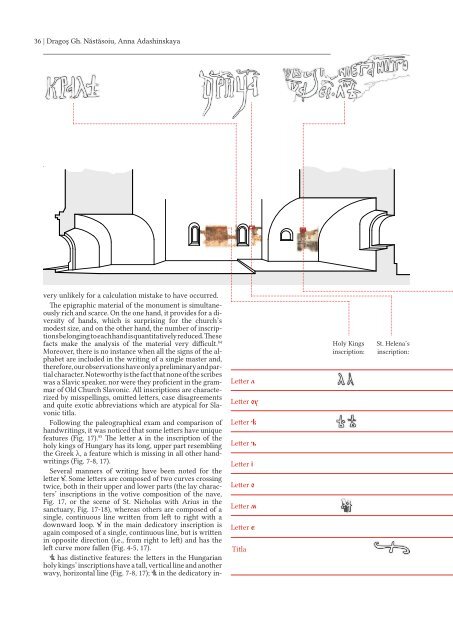Museikon_1_2017
You also want an ePaper? Increase the reach of your titles
YUMPU automatically turns print PDFs into web optimized ePapers that Google loves.
36 | Dragoş Gh. Năstăsoiu, Anna Adashinskaya<br />
very unlikely for a calculation mistake to have occurred.<br />
The epigraphic material of the monument is simultaneously<br />
rich and scarce. On the one hand, it provides for a diversity<br />
of hands, which is surprising for the church’s<br />
modest size, and on the other hand, the number of inscriptions<br />
belonging to each hand is quantitatively reduced. These<br />
facts make the analysis of the material very difficult. 84<br />
Moreover, there is no instance when all the signs of the alphabet<br />
are included in the writing of a single master and,<br />
therefore, our observations have only a preliminary and partial<br />
character. Noteworthy is the fact that none of the scribes<br />
was a Slavic speaker, nor were they proficient in the grammar<br />
of Old Church Slavonic. All inscriptions are characterized<br />
by misspellings, omitted letters, case disagreements<br />
and quite exotic abbreviations which are atypical for Slavonic<br />
titla.<br />
Following the paleographical exam and comparison of<br />
handwritings, it was noticed that some letters have unique<br />
features (Fig. 17). 85 The letter л in the inscription of the<br />
holy kings of Hungary has its long, upper part resembling<br />
the Greek λ, a feature which is missing in all other handwritings<br />
(Fig. 7-8, 17).<br />
Several manners of writing have been noted for the<br />
letter u. Some letters are composed of two curves crossing<br />
twice, both in their upper and lower parts (the lay characters’<br />
inscriptions in the votive composition of the nave,<br />
Fig. 17, or the scene of St. Nicholas with Arius in the<br />
sanctuary, Fig. 17-18), whereas others are composed of a<br />
single, continuous line written from left to right with a<br />
downward loop. u in the main dedicatory inscription is<br />
again composed of a single, continuous line, but is written<br />
in opposite direction (i.e., from right to left) and has the<br />
left curve more fallen (Fig. 4-5, 17).<br />
¸ has distinctive features: the letters in the Hungarian<br />
holy kings’ inscriptions have a tall, vertical line and another<br />
wavy, horizontal line (Fig. 7-8, 17); ¸ in the dedicatory in-<br />
Letter л<br />
Letter оу<br />
Letter ¸<br />
Letter ú<br />
Letter i<br />
Letter о<br />
Letter м<br />
Letter е<br />
Titla<br />
Holy Kings<br />
inscription:<br />
St. Helena’s<br />
inscription:


